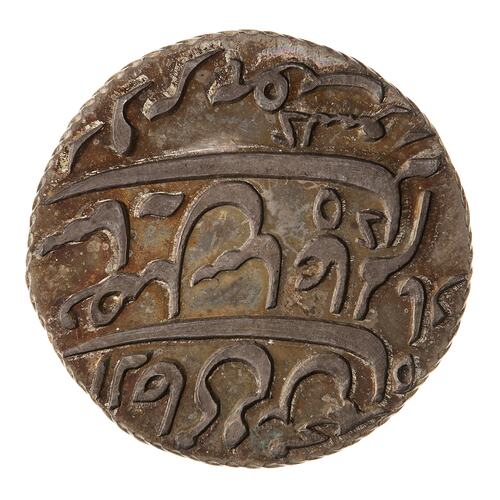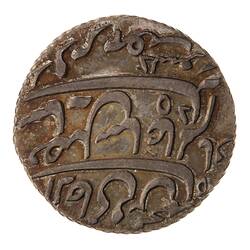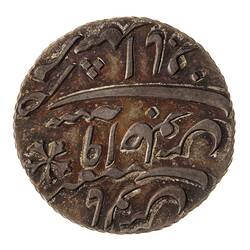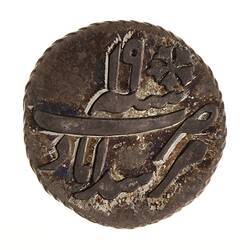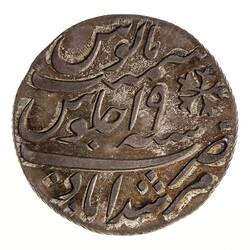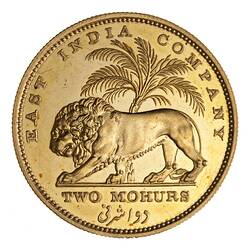Summary
1/2 Rupee or 1/2 Mohur silver pattern, 1793 - proposed coins for Bengal, India
Minted by Calcutta Mint
Struck from unfinished dies with edge milled left
Obverse Description
Persian couplet (Pridmore 11) (translation: Defender of the religion of Muhammad. Shah Alam. Emperor. Shadow of the divine favour, put his stamp on the seven climes.) incomplete die, dots not added
Reverse Description
Persian Julus formular (Pridmore 13) (translation: Struck at the mint of Murshidabad in year 19 of his reign of tranquil prosperity) incomplete die, dots not added
Edge Description
Milled \\\
Significance
Earlier attempts to control the monetary situation in Bengal by the permanent use of the 19th san failed because of the variety of other rupees in use in differents parts of the Provinces of Bengal, Bihar and Orissa. On 1 May 1793 the Governor in Council passed Regulation XXXV which stipulated that only the Company's 19 san gold mohur, sicca rupee and their respective fractions would be used in this area.
The key parts of the Regulation pertaining to coins were:
VII To guard, as far as possible, against counterfieting, clipping, drilling, filing, defacing, or debasing the coin, the edges of both the gold and silvercoin are to be milled, and the dies are to be made the same size as the coin, so that the whole of the impression may appear upon the surface of it.
VIII The nineteenth sun sicca rupees and nineteenth sun gold mohurs, and the halves and quarters of each, which may be coined at the mints established at Dacca, Patna, and Moorshedabad, and at the Calcutta mint, are to be precisely of the same shape, weight, and standard, and bear the same impression both on the surface and the edges; and with a view to the effectual attainment of the last-mentioned object, the dies for striking and milling the gold and silver coin are to be cut in the Calcutta mint, and distributed by the mint-Master to the three subordinate mints, and when these dies are broken or no longer serviceable, they are to be returned to the Calcutta mint.
X The Mint-Master is to cause a private mark to be put upon tall dies which may be prepared for the several mints, but in such a manner as not to be distinguishable by the naked eye. These marks are to be varied as often as the Mint-Master may judge proper upon new dies being made; and he is to keep a register of them, that in the event of any debased or defective coin being found in circulation, he may be able to ascertain from what mint it may have been issued.
Pridmore (p.264) suggests that this piece is an unfinished pattern for the new 1793 issue and could be for either the silver or gold denominations. It is a trial of unfinished dies with edge milled left.
More Information
-
Collection Names
-
Collecting Areas
-
Acquisition Information
Donation from (Estate of) Mr Erich Wodak, John Gartner
-
Date Issued
1793 AD
-
Issued By
-
Mint
-
Denomination
-
Series
-
Material
Silver
-
Axis
12
-
Classification
-
Category
-
Discipline
-
Type of item
-
Dimensions
21 mm (Outside Diameter), 6.211 g (Weight)
-
Shape
Round
-
References
Pridmore 359 KM#Pn13a
[Book] Bruce, Colin R. 2007. Standard Catalogue of World Coins 1701 - 1800.
[Book] Pridmore, Fred. 1975. The Coins of the British Commonwealth of Nations, Part 4, India. 1., Vol.1 p. 263-4 Pages
-
Keywords
